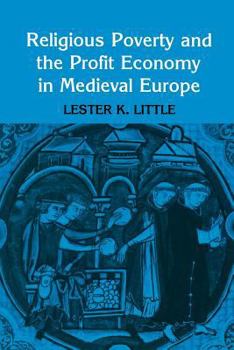Religious Poverty and the Profit Economy in Medieval Europe
Select Format
Select Condition 
Book Overview
"In this stimulating and important book Lester Little advances the original thesis that, paradoxically, it was the leading practitioners of voluntary poverty, Franciscan and Dominican friars, who finally formulated a Christian ethic which justified the activities of merchants, moneylenders, and other urban professionals, and created a Christian spirituality suitable for townsmen. Little has synthesized a vast body of specialized literature in Italian, German, French, and English to write an interpretive essay which provides a new perspective on the interaction between economic and social forces and the religious movements advocating the apostolic ideal of voluntary poverty...Little's book is a major contribution, not only to the history of the religious movement of voluntary poverty, but also to the interdisciplinary study of the middle ages." -- Journal of Social History
Format:Paperback
Language:English
ISBN:0801492475
ISBN13:9780801492471
Release Date:February 1983
Publisher:Cornell University Press
Length:268 Pages
Weight:0.90 lbs.
Dimensions:0.7" x 6.0" x 8.9"
Age Range:18 years and up
Grade Range:Postsecondary and higher
Related Subjects
Encyclopedias Europe History Religion Religion & Spirituality Religious History Religious Studies WorldCustomer Reviews
2 ratings
Brilliant economic/religious take on the High Middle Ages
Published by Thriftbooks.com User , 25 years ago
Little's goal is to explain both the spiritual crisis of the twelfth century, and the rise of new forms of spirituality, especially the mendicants, with the great economic changes of the period. In doing so, he has created a paradigm that, although probably too reductionist, is extremely valuable in providing a foundation for thinking about this critical period in medieval history.He divides the book into four parts. The first, "The Spiritual Crisis of Medieval Urban Culture," talks about the transition from the barbarian gift economy of Bloch's first feudal age to the profit economy of what he terms the commercial revolution of 1000-1300, or the second feudal age, and the resultant spiritual crisis as new forms of life (urban) developed, with which the old forms of spirituality (monastic) could not effectively deal. The second part discusses how some groups, namely the Benedictine monks and hermits, avoided this crisis. A new wave of hermetism developed with men such as Peter Damian and Robert of Arbrissel. Yet these "new hermits" did not entirely withdraw from the world; they were ardent reformers, writers, and preachers, who relentlessly fought against the worldliness of the traditional church, and established precedents that foreshadowed the mendicants.The third part discusses groups that confronted the spiritual crisis. Little talks about the growth of regular canons, about dissent movements that were (Beguines) and were not (Cathars) accepted by the papacy, and finally, the development of the mendicant orders, which built upon the traditions of the preceding in creating a new form of spirituality that was appropriate to the new world.The final part of the book explains how the mendicant orders ushered in what Little calls "an urban spirituality." He explains the role of scholastic social thought, which gradually adjusted to the realities of urban and commercial life, and the development of preaching instead of study as the primary source of spiritual education. Finally, Little expresses his paradigm in its purest form: The monastic spirituality of the first feudal age was a reflection of the gift (or warrior) economy. The monks were the warriors of God, fighting battles (often described with military terminology) against various evils. But as the economy shifted to a commercial economy, a new form of spirituality developed that reflected urban, commercial society. The mendicants taught by preaching -- by trying verbally to convince people to "buy" their "product." This was a spirituality of the marketplace. The new holy men were not rural landlords, like traditional monasteries, but rather itinerant peddlers of Christ, living the lives of merchants in travelling from town to town and preaching. By living in the towns, the mendicants also created much greater opportunities for lay people to participate in religious life, through lay fraternities and religious guilds. Thus, just as urban
A truly seminal work and splendidly readable!
Published by Thriftbooks.com User , 25 years ago
The past is a foreign country and Little is one of the great guides into it. With a fine sense of style and a deep scholarship, he brings together various strands of the Middle Ages which seem to be at odds -- the scope of the Church in what had been envisioned as a purely rural society, the rise of towns, and the new problem of a profit economy. Little explains the rise of the friars, specifically the Franciscans and Dominicans, as an attempt on the part of the Church to aid and better understand the rising urban landscape. The very notions of the moral underpinnings of lending and borrowing are examined ("How may one sell time, all of which belongs to God?") as well as the problem of individual poverty and collective wealth, something often debated within the body of the Church itself. This book will be an eye-opener to all those wishing to understand the place of towns in Medieval society, the place of the friars (as opposed to monks), the origins and rationale behind indulgences, and the general problem of money in what had been a gift-giving society. One of the best history books of the 20th century!





